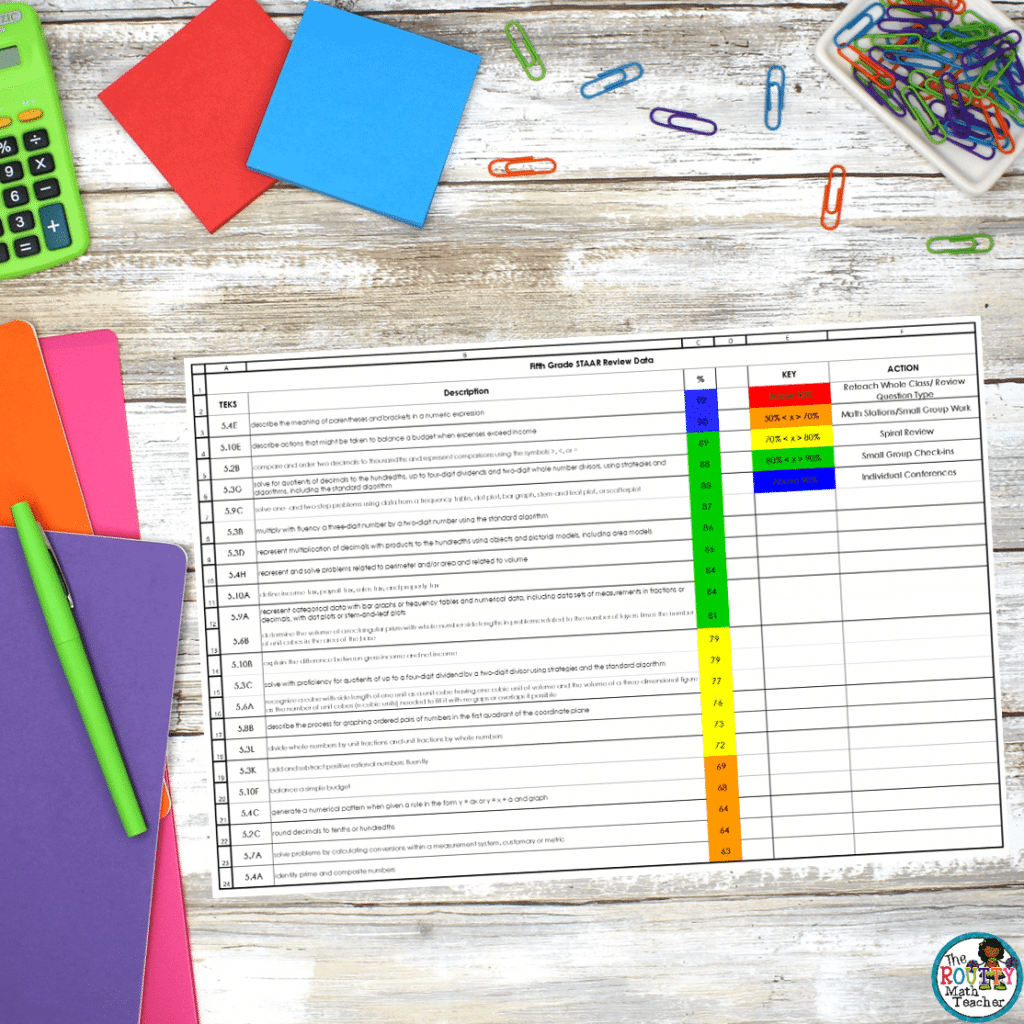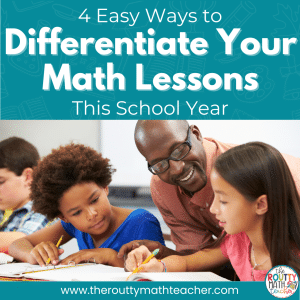Using math stations in upper elementary as a math test review is both a data-driven and engaging way to review grade-level content and skills. In this post, I share how I use math stations to reinforce a year’s worth of content as I prepare for our state math assessment.
It’s the second semester of the school year and every time I open my lesson plan book, that big red circle on my calendar sends blinding flashes to my eyes.
It gives me a headache every time I think about it– it’s like a big roadblock saying, “Do not pass go. Do not collect $200.”
It’s impossible to think about making it to summer without thinking about THIS day.
I know my principal expects results.
And, with this group of students, I’ve got my work cut out for me.
I know I need a plan . . . and fast!
The throbbing of my head forced me to turn the page.
I found my plans for the day and decided I’ll think about it again tomorrow.
Reviewing for the STAAR Test
Preparing for a test that covers an entire year’s worth of content is a challenge.
Over the years, I’ve tried a variety of methods, but I found it’s important to provide ongoing opportunities for students to review grade-level content and skills.
Here are some of the strategies that have been the most effective.
- Using a spiral math review to continuously review and practice grade-level skills.
- Add previously-taught skills to the homework.
- Provide opportunities for students to review grade-level content and skills during morning work.
- Incorporate essential skills into math station rotations throughout the year.
How To Use Math Stations as a Math Test Review
Once we reach the second semester, I know I have to be more intentional about my time and how I choose to approach reviewing for the state test. To do this, I gather data on the grade-level content and skills students learned during the first semester and start building the rotations.
Here’s a closer look at my process.
A. Gather Data
First, I give a practice test early in the second semester.
Then, after students have completed the test, I analyze the results for trends by dividing the standards into categories and using the following colors to analyze my data:
- Blue highlighter: Skills for which more than 90% of the students responded correctly.
- Green highlighter: Skills for which 81% – 90% of the students responded correctly.
- Yellow highlighter: Skills for which 71% – 80% of the students responded correctly.
- Orange highlighter: Skills for which 50% – 70% of the students responded correctly.
- Red highlighter: Skills for which less than 50% of my students responded correctly.
Want to see a video demonstration of this process? Check out this blog post!

B. Plan the Review
Next, I begin scheduling math station rotations to include the standards on which my students need to work.
Generally, I focus on the standards highlighted in yellow and orange, but I also try to weave in the green and blue highlighted skills as time allows. For example, a four-station rotation may include one yellow and two orange stations, as well as one blue or green station.
For the red-highlighted skills, I typically do a classwide reteach session with follow-up activities. Or, if I am short on time, I re-teach the content through my teacher station.
I like to use a four- or five-station rotation system to complete one station rotation per week. This way, I can still move forward with the content I have left to teach or I can use my math lesson time to re-teach the standards my students are still struggling to master.
C. Create the Station Rotations
Here’s the process I use to build my station rotation for a math test review.
1. Create a Plan
I take my test data and decide which standards need to be reviewed by mapping out the standards on a calendar to decide what I will focus on each week.
2. Decide on a Structure to Use
Since the purpose of this rotation is for a spiral review, I like to use a four- or five-station rotation with one 20-minute rotation each day of the week for four or five days to provide practice and intervention.
Teacher Tip: Why a four-day rotation? Our weeks are busy and I sometimes need a day for another required task, so a four-day rotation prevents me from not finishing the rotation or needing to continue it the next week. If I end up with an extra day, I use the day to reteach one of the lowest-performing standards.
3. Choose Resources
I use the TEKS and student performance data to determine an activity for each station during the rotation. This is where I scour my closet and file cabinet looking for resources to use, including the resources I used during each unit to fill my math station buckets.
Depending on how students responded to the questions I used to assess the standard, I may select a new activity to allow the students an opportunity to experience the skill in a different way.
4. Prepare the Resources
I use the plan I created to go down the list and prepare any materials needed for my station rotations. (Yes! This task is lengthy but will pay off in the long run.) While I prepare my resources, I create station task sheets to guide the students and gather game boards, activity/task cards, and recording sheets. I also gather any needed picture books, activity books, manipulatives, or other essentials.
5. Plan for the Logistics
Finally, I iron out some important details, such as the location of storage containers, rotation order, student groups, and tub components.
Location of the Storage Containers
This is the time to think through where to house the storage baskets. I like to store mine on top of the cubby area or on a counter; however, when space is limited, I have been known to stack them in a corner or on the floor at the front of the room.
Rotation Order
Determining the rotation order is essential to helping math stations run more smoothly. I like to post a rotation board to help students know where to go next– it’s super helpful when a rotation spans a few days and students forget where to go next.
Student Groups
Like the rotation board, it’s helpful to post something so students know what group they are assigned to. This is great for absent students and also the forgetful ones. I typically post my groups right next to my rotation board so students only have to refer to one place for the necessary information.
Depending on how students performed, I may create groups based on what individual students need. For example, I may divide students into groups based on the re-teach activity I plan to do with each group– which will differ based on their performance data.
Tub Components
This refers to the general items needed for each tub. For example, each tub needs a set of task directions and activity materials. Some tubs will also need game materials, such as pawns, game markers, dice, coins, playing cards, etc. Other items to add to the station baskets include scratch paper, extra pencils, or dry-erase materials.
Teacher Tip: I like to copy the task sheet on colored paper so it stands out among the other materials. Even better, when I use different-colored station baskets, I copy the task sheet on the same color paper as the basket. I know– I’m completely over the top! 😊
Read more about my time-saving math station hacks here!
Watch Them Go!
With an organized system for reviewing my students’ needs, I don’t cringe when I see that red circle announcing the big state math assessment.
In fact, I feel ultra-prepared because I know I have a plan that will both respond to the needs of my students and engage them at the same time– using a station rotation as a math test review allows me to do both.
Getting started with math stations? Learn more about math stations with my free eBook using the form below.
Sound Off!
What does your state math test review look like? Respond in the comments below.






